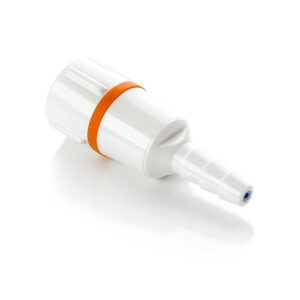Installing firebreaks is an effective step to reduce the medical and financial burden of home oxygen fires.
Around 100-150 people lose their lives in home oxygen fires every year
Firebreaks cost a few dollars to install and last for up to five years
More than 1000 people are treated for burns because of home oxygen fires each year
Home oxygen users in the U.S. are 19 times more likely to die in a fire than those in England, where firebreaks are mandatory

How firebreaks could help the home oxygen industry reduce the medical and financial burden of oxygen fires
With home oxygen fires causing more than 1000 burns per year,1 and complex burns cases racking up costs in excess of $1 million,2 these small devices are a smart, safe investment at just a few dollars each.
The home oxygen and medical gas industries are highly motivated to reduce patient risk wherever possible and are attempting to address the issue through patient education. Many providers install firebreaks as a matter of course, but without a regulatory mandate or reimbursement of installation costs, implementation remains inconsistent.
There are small steps in the right direction: the Veterans Health Administration (VA) issued a Patient Safety Alert in 2018, mandating firebreak installation.3 But this guidance only applies to 6-7% of patients. There are around 1.4 million home oxygen users in the U.S., up to half of whom may continue to smoke.4 With no comprehensive regulation on the horizon, it’s on us as an industry to take the lead.
How firebreaks could help the home oxygen industry reduce the medical and financial burden of oxygen fires
With home oxygen fires causing more than 1000 burns per year,1 and complex burns cases racking up costs in excess of $1 million,2 these small devices are a smart, safe investment at just a few dollars each.
The home oxygen and medical gas industries are highly motivated to reduce patient risk wherever possible and are attempting to address the issue through patient education. Many providers install firebreaks as a matter of course, but without a regulatory mandate or reimbursement of installation costs, implementation remains inconsistent.
There are small steps in the right direction: the Veterans Health Administration (VA) issued a Patient Safety Alert in 2018, mandating firebreak installation.3 But this guidance only applies to 6-7% of patients. There are around 1.4 million home oxygen users in the U.S., up to half of whom may continue to smoke.4 With no comprehensive regulation on the horizon, it’s on us as an industry to take the lead.
Thermal fuses are now reimbursable by Medicaid in Iowa, Kansas, Missouri, North Dakota, and Washington.
According to the International Organization for Standardization (ISO 80601-2-69:2020) a thermal fuse device should be used with oxygen concentrators to stop the flow of oxygen in the event of fire. Firebreaks should be installed at the oxygen source and close to the patient, typically around the patient sternum where the cannula and oxygen supply tube joins.

Contact the Sunset Homecare Division

Contact the Sunset Acute Care Division


Egle Sventnickaite
+1-872-258-1654moc.s1765311110chtes1765311110nus@e1765311110tiakc1765311110intne1765311110vse1765311110

Mason Moss
+1-262-788-1862moc.s1765311110chtes1765311110nus@s1765311110somm1765311110

Owen Ruth
+1-312-533-2451moc.s1765311110chtes1765311110nus@r1765311110newo1765311110

Cindy Geighes
+1-312-533-2478moc.s1765311110chtes1765311110nus@s1765311110ehgie1765311110gc1765311110

Hunter Baudino
+1-262-788-1855moc.s1765311110chtes1765311110nus@o1765311110nidua1765311110bh1765311110

Wyatt Kanemoto
+1-262-788-8941moc.s1765311110chtes1765311110nus@o1765311110tomen1765311110akw1765311110
Contact National Accounts
Nikki Drake
moc.s1765311110chtes1765311110nus@e1765311110kardn1765311110More Info >
- Mastropieri et al. (2020), 18 Stop the Burn: A Smoking and Home Oxygen Safety Initiative with Use of Firebreaks, Journal of Burn Care & Research, 41(1):S15. DOI: https://doi.org/10.1093/jbcr/iraa024.022
- Paradigm (2018), The High Price of Burn Injuries, available at: https://www.paradigmcorp.com/news/the-high-price-of-burninjuries/
- Veterans Health Administration (2018), Patient Safety Alert, available at: https://www.patientsafety.va.gov/docs/alerts/INTERNET_AL18-01.pdf
- Wolff et al. (2016), Flash Burns While on Home Oxygen Therapy: Tracking Trends and Identifying Areas for Improvement, American Journal of Medical Quality, 32(4):445–452 DOI: https://doi.org/10.1177/1062860616658343


















